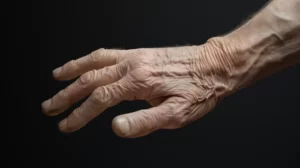Flesh-eating bacteria, also known as necrotizing fasciitis, is a horrifying and potentially life-threatening condition that requires immediate medical attention. Researchers are urging doctors to pay more attention and consider this diagnosis when treating patients with symptoms that may resemble other conditions, like synovitis or cellulitis. It’s essential to catch this infection early to prevent severe complications like amputation or death.
What is Necrotizing Fasciitis?
Necrotizing fasciitis, or flesh-eating bacteria, is a serious bacterial infection that destroys skin, fat, and underlying tissue layers. It usually enters the body through minor cuts, burns, or insect bites and spreads quickly, sometimes as fast as 1 cm per hour, causing severe pain around the affected area and systemic symptoms like fever and low blood pressure.
Three types of necrotizing fasciitis exist, classified based on the bacteria responsible for the infection. Type I, commonly known as polymicrobial, is caused by a mix of anaerobic and aerobic bacteria. Type II, or Group A Streptococcal, is the most common and severe, owed to the Streptococcus pyogenes bacterium, often causing shock and multi-organ failure. Finally, Type III, attributed to Vibrio vulnificus, affects those exposed to saltwater or contaminated seafood.
Though rare, the Centers for Disease Control and Prevention (CDC) reports that about 700 to 1,200 cases of necrotizing fasciitis happen every year in the United States. If not treated promptly, this infection can rapidly spread and lead to severe complications or death.
Early Detection is Key
To avoid these extreme outcomes, early diagnosis is crucial. Dr. Russell Russo, an orthopedic surgeon at the LSU Health Sciences Center in New Orleans, states that patients who have their surgery and debridement (removal of dead tissue) within 10 to 24 hours of presentation do better than those whose diagnosis takes longer.
Diagnosing necrotizing fasciitis can be challenging since its symptoms may closely resemble other, less severe conditions. In the early stages, patients may experience pain, redness, swelling, and warmth in the affected area – all common symptoms of many inflammatory conditions. However, as the infection progresses, symptoms may worsen to include blisters, dark-colored skin (necrosis), fever, and low blood pressure.
Since imaging tests like X-rays and CT scans do not reliably identify necrotizing fasciitis, doctors should not solely depend on them for diagnosis. Instead, a hands-on physical examination is necessary. In some cases, a surgical exploration may be required to obtain a proper diagnosis.
Treatment Options
Once necrotizing fasciitis is diagnosed, the treatment needs to begin as soon as possible. Currently, there are four primary approaches to treating the condition:
- Surgery: Debridement is the most crucial initial step in the treatment, as it involves the removal of dead and infected tissue to prevent further bacterial spread. Surgeons may need to perform multiple surgeries, repeating the debridement until the infection is under control. In severe cases, amputations might be necessary to save the patient’s life.
-
IV Antibiotics: Concurrently with surgery, patients receive intravenous (IV) antibiotics to help facilitate a robust systemic response against the infection. Doctors must choose the appropriate antibiotics based on the type of bacteria responsible for the infection.
-
Supportive Care: Patients suffering from necrotizing fasciitis often require additional medical support in the intensive care unit (ICU). This care may include oxygen, ventilation, and fluids to counteract symptoms like shock and organ failure.
-
Reconstructive Surgery: Once the infection is finally under control, patients often require reconstructive surgery to repair the damage caused by the infection and subsequent surgeries. This process may include skin grafts, flap surgeries, or other cosmetic procedures.
Prevention Measures
While necrotizing fasciitis is rare, taking preventive measures to minimize the risk of infections is always a good idea. Some practical steps to reduce the chances of contracting this severe infection include:
- Properly clean and care for wounds, burns, or insect bites by keeping them clean and dry.
- Seek medical attention for any persistent redness, swelling, or pain near an open wound.
- Practice good hygiene, including handwashing, especially after handling raw seafood, and avoid exposing open wounds to saltwater or brackish water.
- Monitor any existing chronic conditions like diabetes or peripheral vascular disease that may impact the body’s ability to fight infections.
In conclusion, raising awareness about necrotizing fasciitis and urging healthcare providers to consider it as a possible diagnosis can save lives. Remember, this severe condition must be identified early and treated aggressively to limit complications and promote a successful recovery.



